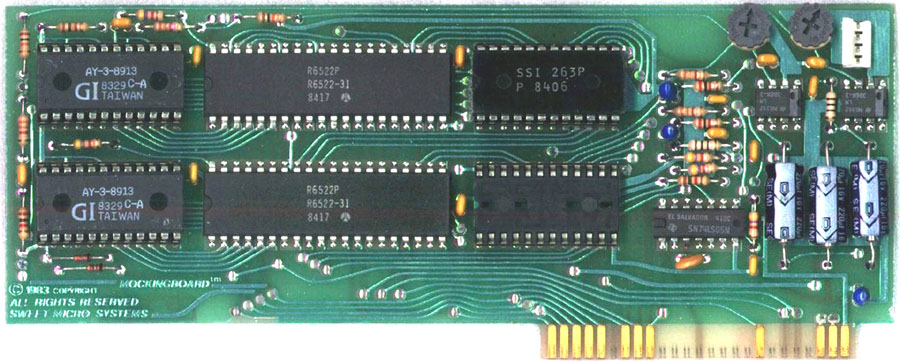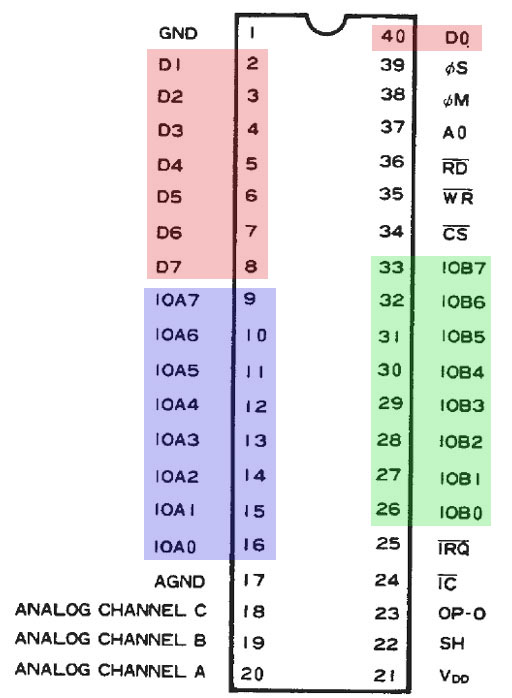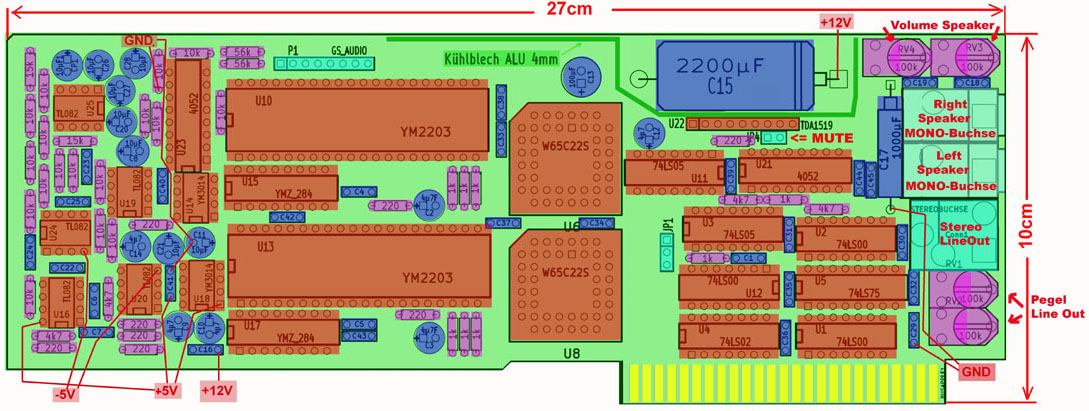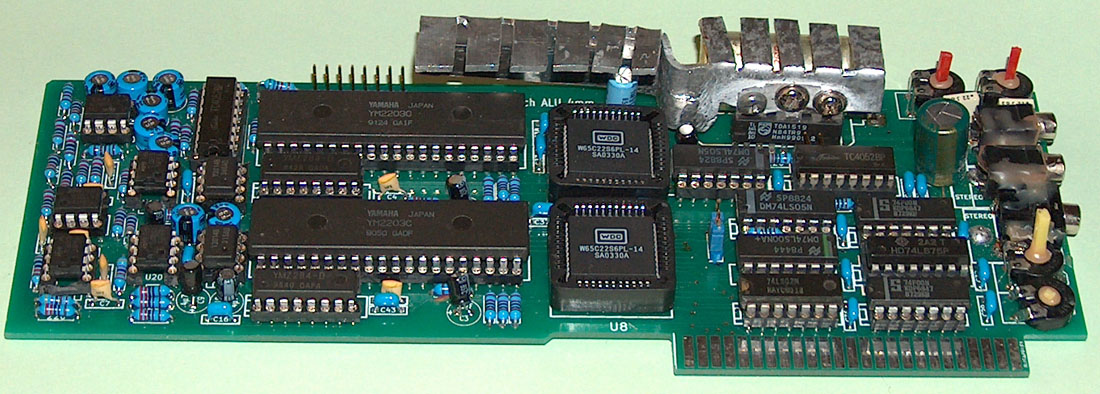|
In the 80īs the
Mockingboard was in itīs way a kind of standard amoung the
soundcards that have been availiable to the Apple
community.
Nearly every game with soundcapabilities offered in the
setup the option to activate soundoutput by one of that
cards. There have been several
versions of the Mockingboard in the market even one version
( D) that supported itīs use with the "slotless" IIc
and the electronics in an external
housing box. The Mockingboard A offered also the ability to
be expanded with speechchips ( the SSI-263A - later replaced
by the SC-01 ) .
In the basic version sold, the soundīchips were missing and
could just be inserted later in the empty reserved sockets.
In fact only very few software
packages really supported the speechchip options.
Nowadays there is also a cloneversion of the Mockingboard A
availiable at ebay and as a remarkable
"special version" there is also a version sometimes offered
with a tiny tube-amp preamlifier for enthusiasts of the "old
fashioned tube amp sound".
Here the pinouts of the speechchip:
| |
the pinout of the SSI-263A |
|
the pinout of
SC01 |
|
| |
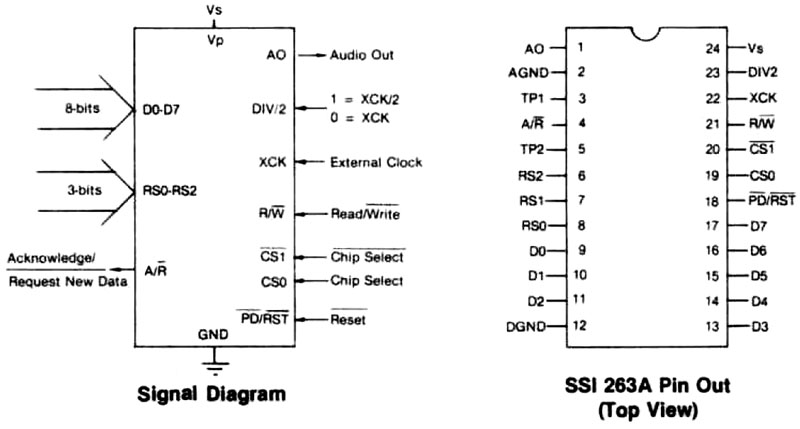 |
|
 |
|
here a picture of the Mockingboard A with the
soundchips inserted:
In the end of the last year a pal of mine here
in Germany started a discussion with me about another kind of version to
the mockingboard with the
YM-2203 chip from Yamaha that also was used later in commercial
organ/synthiszer like keyboards for kids and amateur musicians. By the
datasheet
Yamaha claims it to be a pincompatible replacement of the AY-3-8910
soundchip that is used some versions at the Mockingboard with several
advantages
compared with the former chip: It has more internal Registers and
instead of 3 Sound outputs it has internal 9 soundgenerators with far
more
soundprogramming options. The external circuitry is nearly exact the
same as at the Mockingboard with the AY-3-8913. And Yamaha offers also 2
other very
interesting alternate chips invery smaller packages of which Yamaha
claims that they are at least in their internal programming and handling
"compatible"
with the AY-3-8910 / AY-3-8913.
| |
the pinout
of the AY-3-8910 |
the pinout
of the AY-3-8912 |
the pinout of the
AY-3-8913 |
|
| |
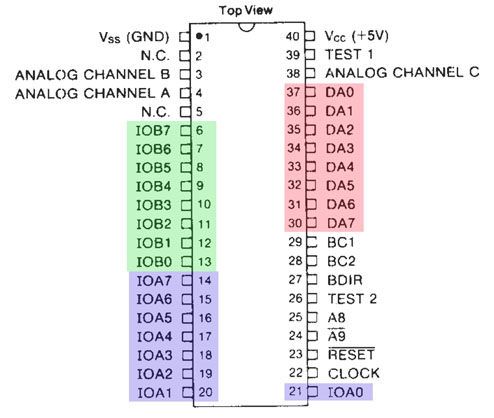 |
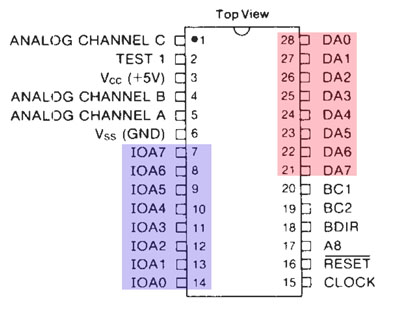 |
 |
|
Datasheet of the 3 chips AY-3-89XX
Experienced technicians of course could argue that also the 40 pin chip
AY-3-8910 has some smaller "versions" : The AY-3-8912 in 28 pin chip and
the
AY-3-8913 in the 24 pin Chip. The difference is resulting from the fact
that this chips have less "Output/Input ports". The AY-3-89810 has 3 of
them a port
A,B and C with each 8 Bits. This offers additional communications with
the chip itself and from the chip to other chips. The smaller versions
only have 2
Output/Input ports ( A and B at the 8912 ) or only one port A at the
8913 and thereby reducing the need of pins at the 8912 by 8 pins less
and by 16 pins less
at the 8913.
But with the YAMAHA chips and the advantaged ínternal stucture permits
a design of much better sound.
As explained in the previous text the YM-2203
is pin- and software compatible with the AY-3-8910. The YMZ-284 is not
pincompatible ( and much smaller
than the AY-3-8913 but internal it is too software compatible with the
AY-3-8913. The real jump in size is the YM-3014 - of which YAMAHA claims
to be the
smallest software compatible chip to the AY-3-8913. This advantage is
result of the fact that the control and communication is not performed
by 8
parallel lines - but insteadby serial line.
Additionally my pal demanded the Soundcard also to support the ability
to support and use the IIGS Soundchip alternatively and offering a
Sound-Output-
Amplifier with at least 2 Watt power per Channel / Speaker. The card
should also offer the compatibility to the software used in most games.
Comparing the Mockingboard with itīs
basic configuration ( without the sparely supported speech
chips ) to the intended card the difference shows
up as follows:
| |
|
|
The Mockingboard A |
|
The planned Soundcard |
|
| |
Pick sound from IIGS |
|
no |
|
yes |
|
| |
Software compatible to AY-3-8913 |
|
yes |
|
yes |
|
| |
Hardware compatible to AY-3-8913 |
|
yes |
|
yes |
|
| |
Stereo 3 channel sound |
|
yes |
|
yes |
|
| |
Watt Power Output to speaker |
|
max. 1,5 - per channel |
|
max. 8
- per channel |
|
| |
Squarewave channels |
|
3 - per channel |
|
9 - per channel |
|
| |
Sinewave channels |
|
1 - per channel |
|
3 - per channel |
|
| |
Noise Generators |
|
1 - per channel |
|
3 - per channel |
|
| |
FM channels |
|
0 - per channel |
|
1 - per channel |
|
The next point ( at least about compatibility
) was that the card also is equipped with VIA chip 6522 per channel. The
difference to the Mockingboard
is, that the new card will use the 65c22 (
datasheet ) -version instead due to the fact of itīs smaller size in
the PLL44 package.
So the resulting first design looked like this:
and the prototypcard looked like this:
In simple words: because the card contains per
channel ecah a YM-2203, a YMZ-284 and the YM-3014 controlled by the
65C22 - you can state
that each channel contains 3 software AY-3-8913 compatible chips. The
stereo audio amplifier chip is generally used in car-amplifiers passing
max.
of 8 to 9 Watt per speaker and therefor it should have additional
cooling - resulting to the fact that the aluminium cooling plate was
designed
specially designed for this card with minimum space requirements.
Story continued at
next
page.
|


